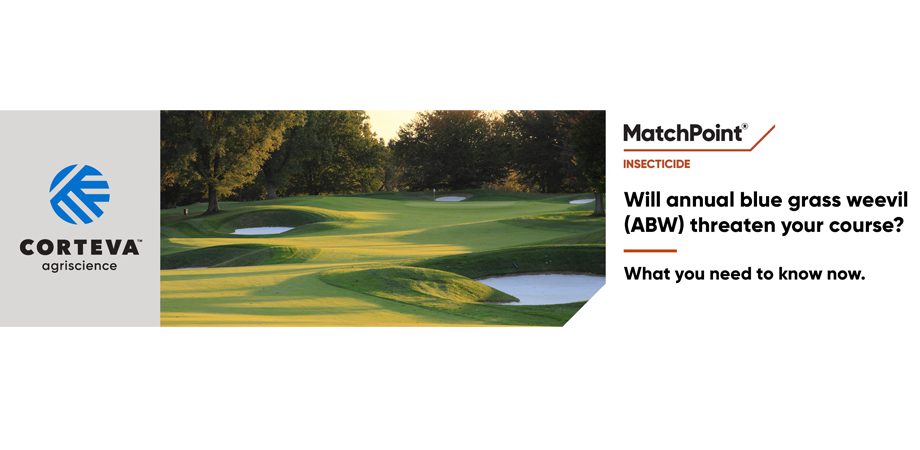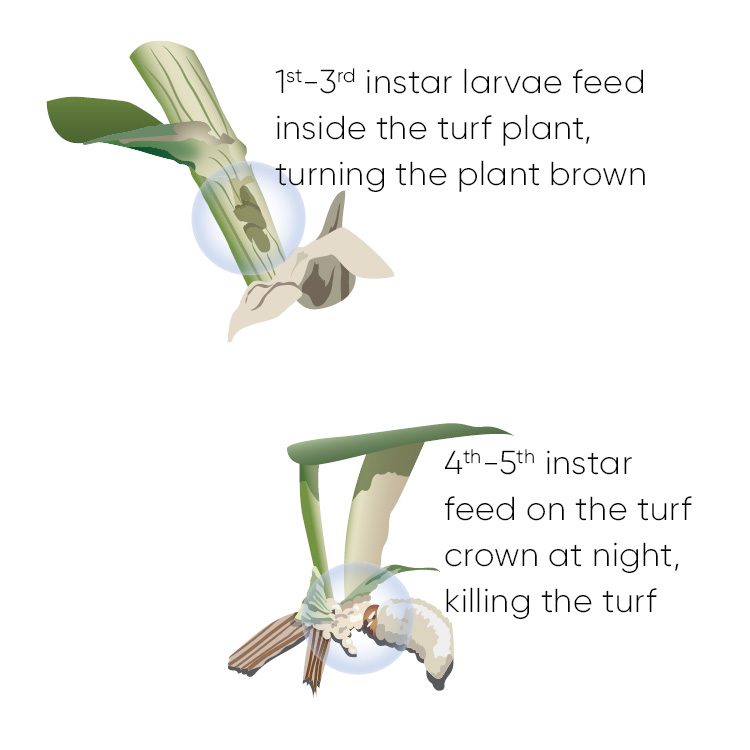Will Annual Blue Grass Weevil (ABW) Threaten Your Course? What You Need to Know Now.

We asked Corteva a few questions about the annual bluegrass weevil (ABW). Hear about where the insect is causing problems today, where it’s spreading, how to identify if it’s the issue, how to treat it, and more in this Q&A.
In what areas does the annual bluegrass weevil predominately cause issues?
The annual bluegrass weevil, Listronotus maculicollis, has been predominantly problematic in the Northeast, New England, the MidAtlantic states, and – more recently – damage caused by ABW has been reported in OH, KY, WI, WV, and NC. For years, it was believed that this turfgrass insect pest primarily fed on annual bluegrass (Poa annua), but recent research and field observations have shown damage to other highly maintained turfgrasses. ABW adults overwinter in protected areas around a golf course, including tree litter, brush, and roughs. In spring, they emerge and migrate to shorter turf (fairways, collars, greens, and tees), where they lay eggs between the sheath and stem. The larvae feed on the turf as they develop, turning turfgrass yellow or brown.
Is the annual bluegrass weevil spreading into other areas? If so, why and where?
Recent indications are that infestations have spread West and Southwest. University of Wisconsin at Madison, as recent as summer 2020, posted a New Pest Alert that ABW had been found in Wisconsin. It is believed to have been spread by sod purchased from the east several years before1.
What are the indicators of an annual bluegrass weevil issue?
A first indication of ABW on a golf course is the presence of over-wintering adults in the short-mown areas in early spring, where females seek host plants in which to lay eggs. Early instar larvae feed within the plant, and as the larvae mature to 4th and 5th instars, they drop out of the plant and begin feeding at the crown of the turf plant. Damage is observed in late spring/early summer expressed as small, yellow-brown spots beginning to appear at first at the edges of fairways, greens, and tees. The scattered dead spots eventually grow together. One might notice necrotic leaves have been tunneled and then break off at the crown. ABW larval damage can often be mistaken for anthracnose or other turf stresses.

How can we definitively diagnose an annual bluegrass weevil problem?
Several scouting methods have been used to determine the presence of ABW and which life stages are most prevalent. Some of these include pitfall traps, monitoring grass clipping for adults, vacuum sampling, displacing them with soap solutions that encourage them to break the surface, and core sampling. ABW adults are dark brown or black beetles approximately 1/8” long with a curved snout and grey-yellow hairs and scales on the thorax and hind wings. The larvae are cream-colored with red-brown heads and legless.
What are the challenges we face when controlling the annual bluegrass weevil?
ABW control challenges are faced during both the adult and larval stages. If you choose to target the adults with an adulticide, application timing and understanding peak adult movement can be a challenge, especially if you have no historical record of ABW. ABW has developed resistance to many traditional adulticides which can limit control options. Environmental conditions each spring can also be a challenge during the migration stage. As the infestation transitions into the larval stages, the first generation ABW population is very important to target as a turf manager. This generation is typically when the ABW population will be most “synchronized” to maximize your control with a larvicide. Later generations and less synchronous life stages during a season can make timing applications more difficult. The bottom line is that scouting is important in effectively managing ABW and optimizing performance of any application.
When should we start our insecticide applications to control the annual bluegrass weevil?
If an adulticide is part of your control strategy, a dependable phenological indicator to time an application targeting ABW adults is when Forsythia is about half-green/half-gold. Peak adult movement often occurs at this time. A dependable phenological indicator for targeting 1st generation ABW larvae is when Catawba Rhododendron Hybrid (Rhododendron catawbienses) is in full bloom.
A great foundation tool for your ABW program is MatchPoint® insecticide. MatchPoint is a critical resistance management tool with an innovative formulation of spinosad for superior control of ABW larvae. Turf managers should time a MatchPoint application when a majority of the ABW larvae reach 3rd instar growth stage. This is typically a couple of days to a week after full bloom of the Catawba Rhodendron Hybrid in your area. MatchPoint works through contact and ingestion and results in quick knockdown of the larvae, stopping feeding immediately. It has a unique Group 5 mode of action, which makes it an excellent choice for rotation programs because it is the only Group 5 insecticide available for ABW control. MatchPoint is an innovative solution for ABW control using the power of spinosad in a new, advanced lignin formulation. It offers enhanced photostability, giving superintendents more application flexibility because watering can be delayed up to 24 hours.
Click here for a short video on Matchpoint insecticide.
What other insects do you see causing big problems this year that we can help control in the spring?
Insect pest populations can be unpredictable from year to year. Scouting is important to properly identify these pests and their infestation levels in order to determine the most effective control strategies. MatchPoint insecticide provides control of many common pests on the golf course including armyworms, cutworms, and sod webworms in addition to ABW.
1Koch, P., McGraw, B., & Liesch, P.J. (2020, July 1) NEW PEST ALERT: Annual Bluegrass Weevil in Wisconsin. Turfgrass Diagnostic Lab, University Wisconsin Madison. Retrieved from https://tdl.wisc.edu/annual-bluegrass-weevil/
™®Trademarks of Corteva Agriscience and its affiliated companies. MatchPoint is not registered for sale or use in all states. Contact your state pesticide regulatory agency to determine if a product is registered for sale or use in your state. Always read and follow label directions.
©2021 Corteva







